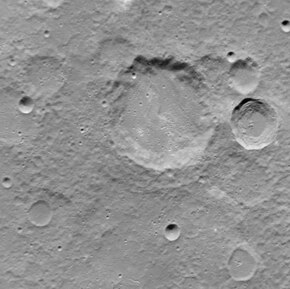
Petrarch is a crater on Mercury. This crater is located within the distorted terrain on the opposite side of the planet from the Caloris Basin. It was named after Petrarch, the medieval Italian poet, by the IAU in 1976.
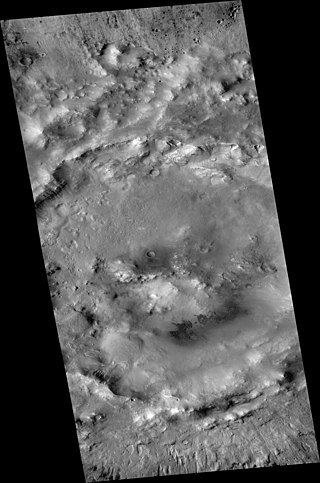
Davies is a crater on Mars located at 46°N 0°E on the fringe of Acidalia Planitia near Arabia Terra. It is approximately 48 km in diameter. The crater's name was formally approved by the IAU in 2006.

de Gerlache is a lunar impact crater that is located along the southern limb of the Moon, within a crater diameter of Shackleton at the south pole. From the Earth this crater is seen from the edge, and it lies in perpetual darkness. Thus little or no detail can be seen of this crater, other than the edge of the rim. However, the crater is clearly visible in Earth-based radar images. The crater is roughly circular, with some slight wear. No craters of note overlie the rim, although some formations may be attached to the southern and western edges.
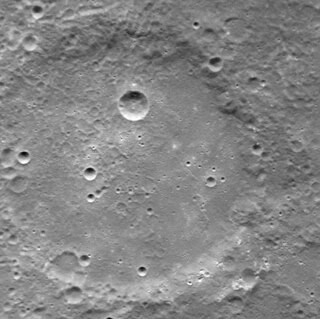
Africanus Horton is a circular impact crater on Mercury. It was named by the IAU in 1976, after Africanus Horton, a Creole African nationalist writer and an esteemed medical surgeon in the British Army from Freetown, Sierra Leone.

Matisse is an impact crater on the southern hemisphere of Mercury. Matisse takes its name from the French artist Henri Matisse, and it was named by the IAU in 1976.

Raphael is a crater on Mercury. Its name was adopted by the International Astronomical Union (IAU) in 1976, and is named for the Italian painter Raphael. It is Tolstojan in age. The crater was first imaged by Mariner 10 in 1974.
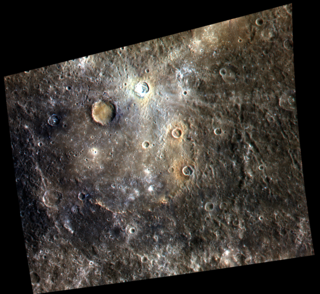
Homer is a crater on Mercury. It is one of 110 peak ring basins on Mercury. It is Tolstojan in age.

Holbein is a crater on Mercury. Its name was adopted by the International Astronomical Union (IAU) in 1979. Holbein is named for the Germain painters Hans Holbein the Elder, who lived from 1465 to 1524, and Hans Holbein the Younger, who lived from 1497 to 1543.

Monet is a crater on Mercury. Its name was adopted by the International Astronomical Union (IAU) in 1979. Monet is named for the French artist Claude Monet, who lived from 1840 to 1926.

Neumann is a crater on Mercury. It has a diameter of 120 kilometers. Its name was adopted by the International Astronomical Union (IAU) in 1976. Neumann is named for the German architect Johann Balthasar Neumann, who lived from 1687 to 1753.

Karsh is a crater on Mercury. It has a diameter of 58 kilometers. Its name was suggested by American resident Elizabeth Freeman Rosenzweig in a naming contest which was eventually adopted by the International Astronomical Union (IAU) on 2015. Karsh is named for the Armenian-Canadian photographer Yousuf Karsh. The craters Carolan, Enheduanna, Kulthum, and Rivera were also named as part of the contest.
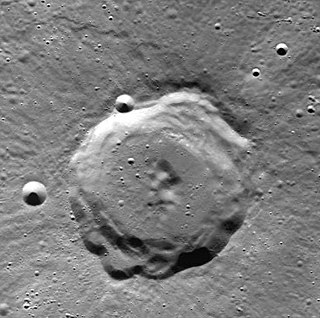
Rivera is a crater on Mercury. It has a diameter of 40 kilometers. Its name was suggested by Mexican residents Ricardo Martinez and Arturo Gutierrez, and American residents Rebecca Hare and José Martinez, in a naming contest which was eventually adopted by the International Astronomical Union (IAU) on 2015. Rivera is named for the Mexican poet Diego Rivera. The craters Carolan, Enheduanna, Karsh, and Kulthum were also named as part of the contest.

Villa-Lobos is a crater on Mercury. Its name was adopted by the International Astronomical Union (IAU) on September 25, 2015. Villa-Lobos is named for the Brazilian composer Heitor Villa-Lobos.

Shevchenko is a crater on Mercury. Its name was adopted by the International Astronomical Union (IAU) in 1976, for Ukrainian poet Taras Hryhorovych Shevchenko.
